The tale is not beautiful if nothing is added to it.-Italo Calvino, folklorist
Jim Henson’s The Storyteller only ran for nine episodes, which doesn’t really surprise me since its a very niche show. (I like to think it would have done better in the age of streaming.) But being so niche made it special and being so short allowed it to maintain a very consistent quality rate.[1]It had a spinoff about Greek myths which only lasted four episodes. While it’s just as great as the main show, tracing down different versions of classical myths is a more daunting task for me … Continue reading This was largely due to the scripts by Anthony Minghella, which manage to sound both poetic and folksy. They perfectly capture the feel of a folktale without sounding exactly like any written fairy tales I’ve read. Something I think they deserve more credit for is how they adapt the stories on which they’re based. Even the show itself doesn’t give itself enough credit for this. The credits simply say “adapted from an early Russian folktale” or “adapted from an early German folktale,” without even giving the title of those tales.[2]The episode, The Luck Child credits a “Russian folktale” and the costumes certainly set it in that country, but I’ve been unable to hunt down what that folktale might be, so … Continue reading What Minghella often does is take one half of one story and the other half of another and combine them, or take different aspects of similar stories to make an ultimate version.[3]Howard Pyle does much the same thing in his books, The Wonder Clock and Twilight Land. Given how many fairy tales share plot points and how many of them already feel like combinations of different plots, this is something you’d hardly notice if you didn’t do research. He also adds emotional and psychological depth to the characters while still keeping the simple feeling of a folktale. In fact, it captures the spirit of folklore better than any fairy tale themed show I can remember. This post is going to analyze how each episode adapts its source and whether it improves it or not.
Hans My Hedgehog
In this episode, a woman (Maggie Wilkinson) wishes for a child so badly, she says that she wouldn’t care if it were like a hedgehog. Years later, a king (David Swift) accidentally promises his daughter (Abigail Cruttenden)’s hand in marriage to a half man-half hedgehog creature (Ailsa Berk.)
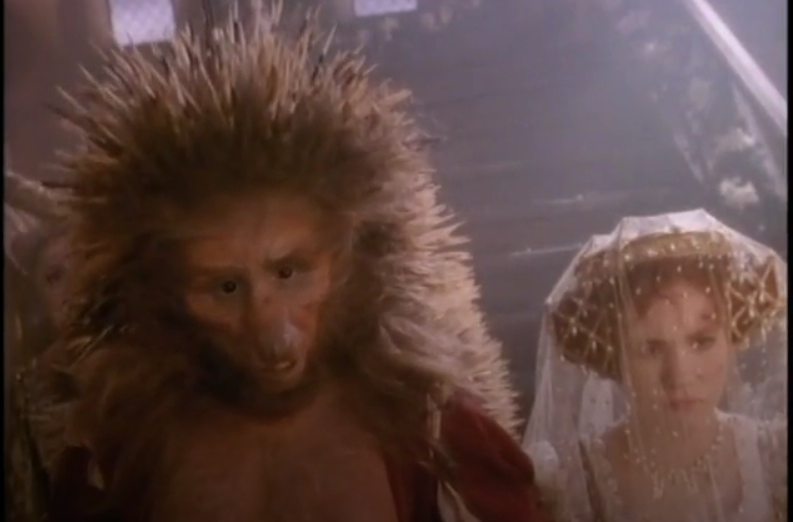
The episode’s first act sticks relatively closely to the fairy tale canonized by the Brothers Grimm of the same name. But the second half goes in a quite different direction. Instead, this episode takes a page from Peter Christen Asbjornsen and Jorgen Moe’s East of the Sun and West of the Moon, another Beauty and the Beast variant, in which the heroine discloses a secret of her husband’s to a family member, does something forbidden, loses her husband as a result and must go on a quest to find him.[4]This plot dates back to the myth of Cupid and Psyche. The way in which Hans is ultimately freed from his hedgehog form is reminiscent of the ballad of Tam Lin. While this version loses the symmetry of the dishonest king and princess vs. the honest ones, it makes for much better drama than the rather limp ending to the Grimm story in which Hans simply tells his bride how to break the spell over him and she does so.
Fearnot
Nothing scares Fearnot (Reece Dinsdale), a good-for-nothing tailor’s son. So he sets out to learn how to shudder-only to find out how at home.
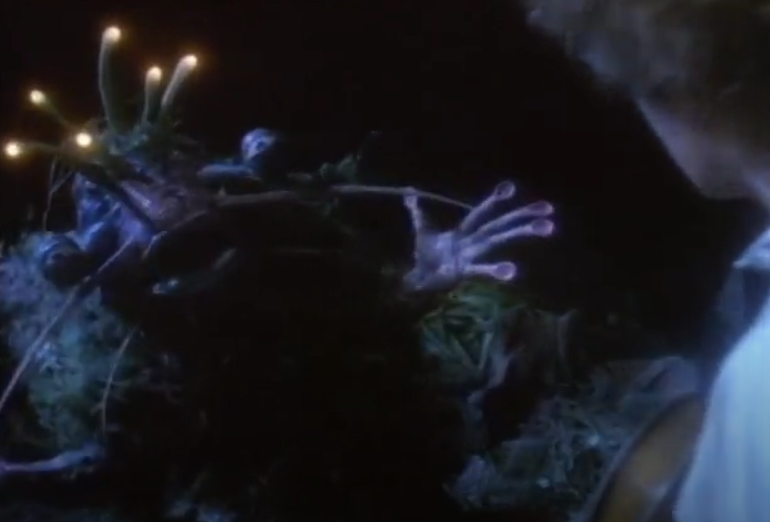
This episode has the exact premise and structure of The Tale of a Youth Who Set Forth to Learn What Fear Was (Grimm) but changes nearly all the details. [5]Since I’m not super familiar with the different variants of this story, I can’t say which of the incidents come from Minghella’s imagination and which from them. I’d love it … Continue reading The scene that comes directly from the original is that of the man divided in half, who comes down the chimney of the haunted castle and plays nine pens with skulls and bones, to which this retelling adds a fine gloss by giving a different meaning to his being split in half and to his game. The episode expands on the throwaway character of the man the hero meets, who advises him on where to go for a fright, making him the Irish huckster, McKay (Willie Ross), and adding a buddy comedy element to the story. It stays true to the essence of the original ending, in that Fearnot finally gets the shivers because of his love interest (here played by Gabrielle Anwar) and it’s something commonplace rather than any of the fantastic horrors he meets, but it reimagines it as a dramatic scene rather than a comedic one. I wouldn’t say the result of all this is an improvement on the source material, as is Hans My Hedgehog, but it sure doesn’t come up short to it either.
A Story Short
A wandering storyteller (John Hurt) is condemned to be boiled in oil unless he can tell a different story to a king (Richard Vernon) every day for a year. All goes well for him…until the last day when he can’t think of another story.
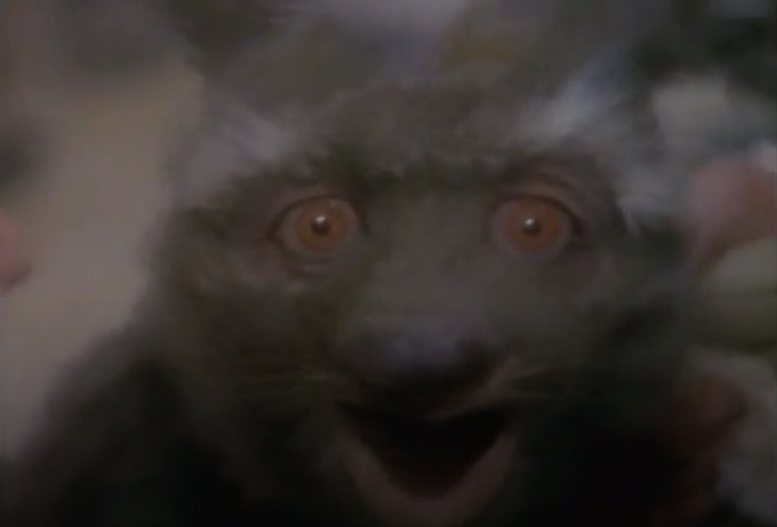
This is the only episode to be adapted from a Celtic tale, The Storyteller in Peril (Joseph Jacobs), and the result is easily the weirdest episode by a long shot! It starts off normally enough by borrowing the familiar story of Stone Soup. This serves to create a different relationship between the storyteller and the king and a much more suspenseful situation. (If the original storyteller couldn’t come up with a new story, he’d just be disgraced, not executed.) It also gives the mysterious beggar (John Kavanagh) more of a motivation for what he does. The surreal adventures on which he leads the storyteller are reimagined and sanitized to an extent. The detail of the storyteller’s wife (Brenda Blethyn) leaving him for the beggar at the drop of a hat, however, is reimagined to make it more tragic, ending the episode on a wry, wistful note about the difference between stories and reality.
The Luck Child
It is prophesied that the seventh son of a seventh son (Steven Mackintosh) will one day be king. The evil reigning monarch (Philip Jackson) tries to get rid of him-but this proves to be easier said than done.
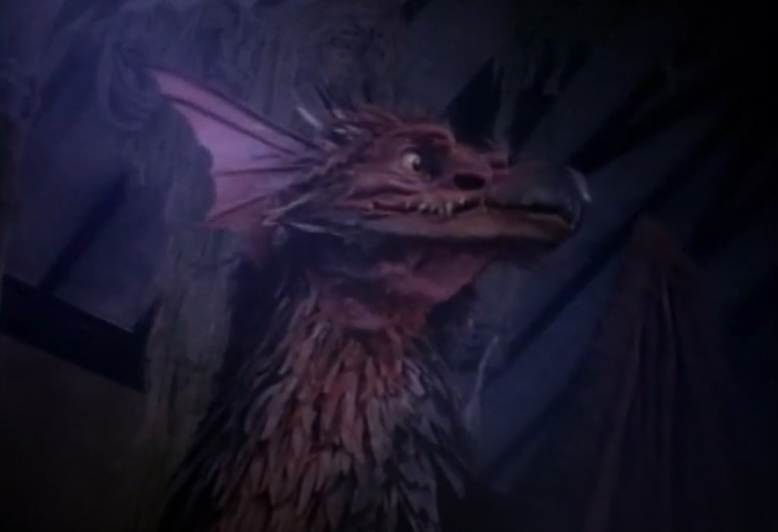
This episode takes most of its plot from The Devil With the Three Golden Hairs, but it has the hero’s task be taking a feather from a gryphon, as in the similar Grimm fairy tale, The Gryphon, rather than hair from the Devil, though they make it a golden feather, I suspect, as a nod to the first story. (Maybe since The Storyteller would descend into Hell in The Soldier and Death, they didn’t want to take the trip twice.) It also combines the characters who help the hero at different points of the story (a band of robbers in the first half and the Devil’s grandmother in the second) into one character (Anthony O’ Donnell.) The three questions to which the hero must find answers are whittled down to the one that’s most necessary to the story and the number of feathers is correspondingly reduced to one. This makes for a shorter and less suspenseful climax, but it does have the benefit of eliminating the hero’s one immoral act: he no longer has to lie to the king about how he gets so much gold.
The Soldier and Death
As a reward for giving his last biscuit to a beggar (Walter Sparrow), a poor soldier (Bob Peck) is given a magical set of playing cards and a magical sack. These eventually lead him to a confrontation with Death itself (Alistair Fullerton.)
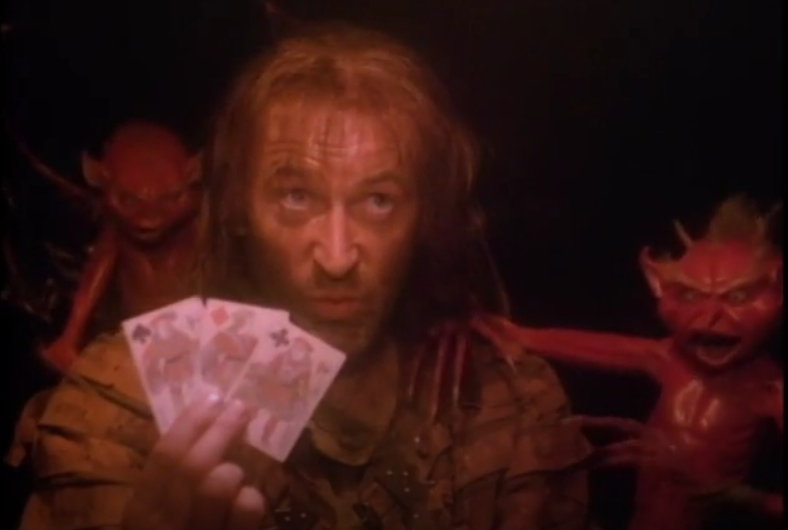
Unusually for the show, this episode is quite faithful to one particular story, Arthur Ransome’s The Soldier and Death. Perhaps that’s why it’s not more of a favorite of mine, though of course, folktales being what they are, viewers will recognizes plot points and ideas from elsewhere. [6]Aficionados of the Brothers Grimm will be reminded of Godfather Death, Gambling Hansel and Brother Lustig. And it’s certainly a striking story as it is.
The True Bride
A poor orphan girl (Jane Horrocks) completes three impossible tasks for a cruel troll (voiced by Alun Armstrong) with the help of a magic lion (voiced by Michael Kilgarriff.) Then she must go on a journey to find her missing bridegroom (Sean Bean.)
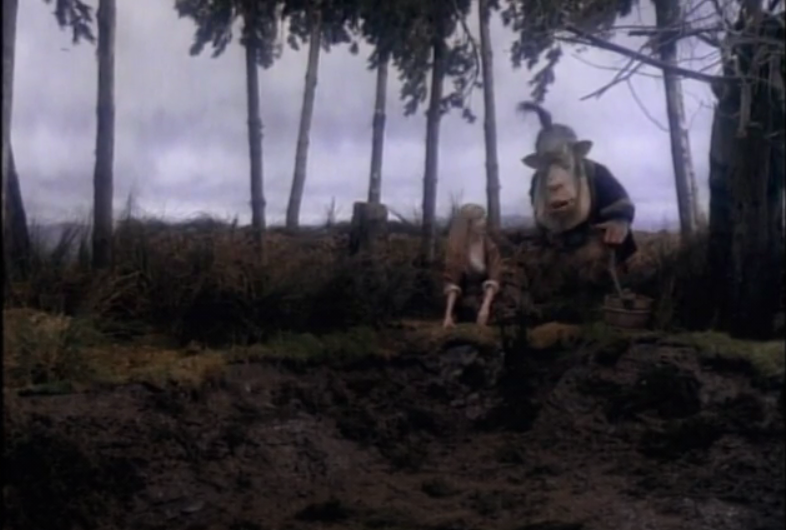
This is another episode that’s a clear improvement over its Grimm source. It replaces the generic wicked stepmother and fairy godmother figures of the first half with the more interesting troll and “Thought Lion.” And it completely reimagines the second half where the bridegroom forgets the bride and has to be reminded of her[7]Lovers forgetting their betrotheds, either through enchantment or because they’re just stupid, is a surprisingly common plot in Grimm. The version in The True Bride is probably the worst, with … Continue reading, a rather generic variation on Cinderella, with a version of East of the Sun and West of the Moon‘s final act.[8]Actually, there are many fairy tales with that story’s climax, like The Iron Stove or The Singing, Springing Lark. Perhaps I should cite one of them as the inspiration for this episode since … Continue reading But if you’re a fan of Cinderella, don’t be disappointed. The Storyteller would do a better variation in Sapsorrow.
The Three Ravens
Three princes are transformed into ravens by their wicked stepmother (Miranda Richardson.) To break the spell, their sister (Joely Richardson-apparently no relation to Miranda) must go three years, three months, three weeks and three days without speaking a word.
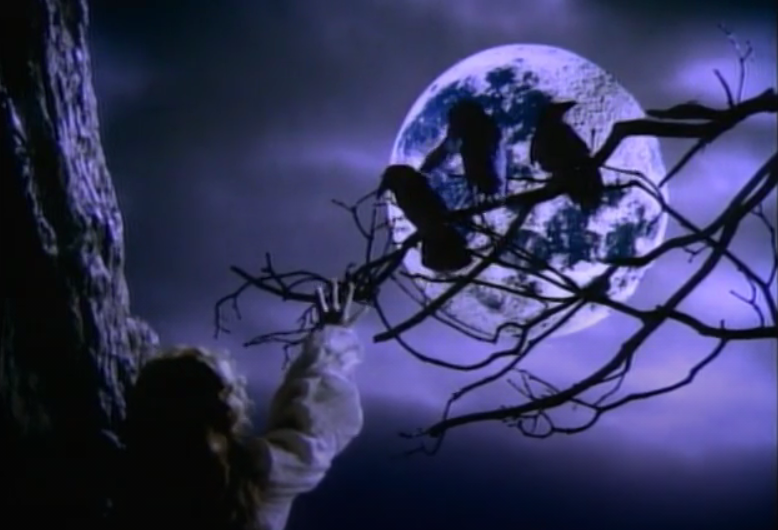
Heroines who must save their several brothers, who have been turned into birds, usually by taking a vow of silence, are in many fairy tales. This episode takes its plot largely from the Brothers Grimm’s The Six Swans, though it uses the same species of bird as The Twelve Brothers and The Seven Ravens. It tightens the story by killing off the dropped character of the princess’s father (Jonathan Pryce) and combining the two evil queens/mother figures into one. The result is my favorite version of the Silent-Sister-With-Bird-Brothers plot, with the arguable exception of Hans Christian Andersen’s The Wild Swans.
Sapsorrow
To escape being forced to marry her father (Geoffrey Bayldon), Princess Sapsorrow (Alison Doody) must flee. Sometime later, in another kingdom, a strange creature of fur and feathers works in a prince (James Wilby)’s castle-and a mysterious beauty beings appearing at royal balls.
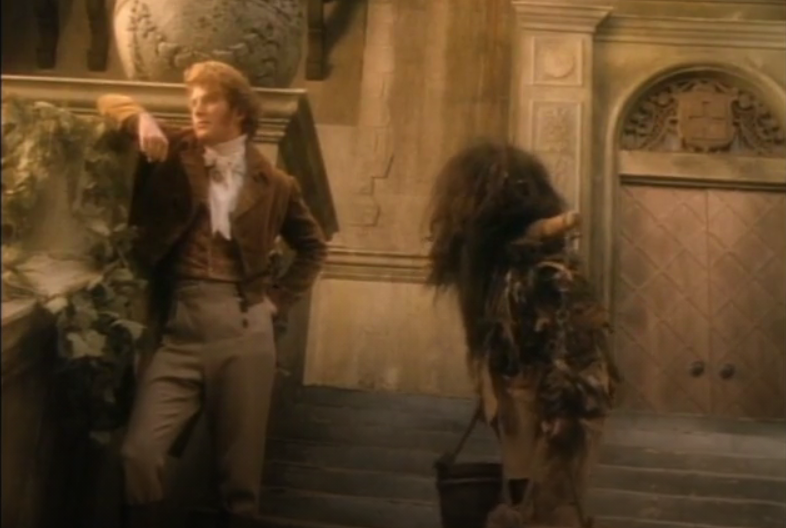
This reimagining of Grimms’ Allerleirauh[9]There’s not really a good translation. It’s something like Lots-of-Different-Furs. sanitizes the incest theme by having the king be required to marry his daughter by an ancient tradition involving a ring rather than him simply desiring her. A bit contrived, but, hey, fairy tales generally are. It also livens up the story with two evil sisters (Dawn French and Jennifer Saunders) who could have come from any fairy tale. The second half of the story is changed to be closer to Cinderella with Sapsorrow leaving a slipper behind at a ball and the prince marrying whoever fits it.[10]This episode is closer to the Grimm versions of Allerleirauh and Cinderella than those by Charles Perrault. The princess’s disguise is made from the fur of many different animals and her … Continue reading Notably, unlike in Allerleirauh where the king forces the heroine to reveal her true nature against her will, here the prince has to agree to marry Sapsorrow while she’s still in her Straggletag disguise. While it’s debatable if this gives the prince enough of a redemption, given what a jerk he’s depicted as initially, it helps make this my favorite variation of Allerleirauh.
The Heartless Giant
A dangerous giant with no heart in his body (voiced by Frederick Warder) tricks young Prince Leo (Elliot Spiers) into releasing him from the royal dungeon. To atone for his mistake, Leo must go on an arduous quest to reunite the giant with his heart.
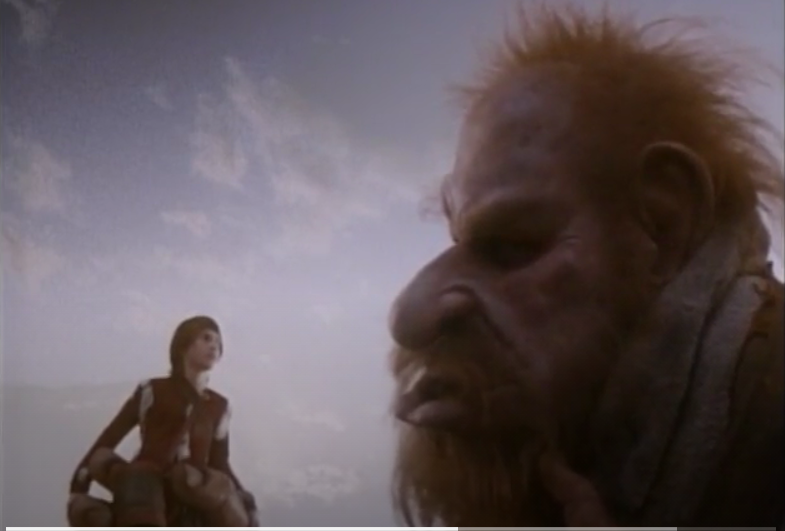
Asbjornsen and Moe’s The Giant Who Had No Heart in his Body features the familiar fairy tale trope of the animals whom the hero helps along his way coming back later to help him achieve his impossible tasks, and this adaptation adds another familiar device of three sons, princes as often as not, setting out on a mission and only the youngest one accomplishing it. (For the record, I don’t mean that as a criticism. If anything, I’d be disappointed if the show didn’t have an episode like this.) But it completely reimagines the beginning of the story and drops the character of the imprisoned princess, making it much more about Leo’s relationship with the giant.[11]This arguably owes something to Iron Johannes. Maybe that’s the reasoning behind the “early German folktale” credit. The cheerfully cruel, but arguably justified, treatment of the giant in the original’s ending takes on a darker shade here, making for a story about guilt, betrayal and lost innocence, and ending the series on a bittersweet note. By which I mean that the story is a bit sad, not that it’s in any way inferior to the eight wonderful episodes that preceded it.
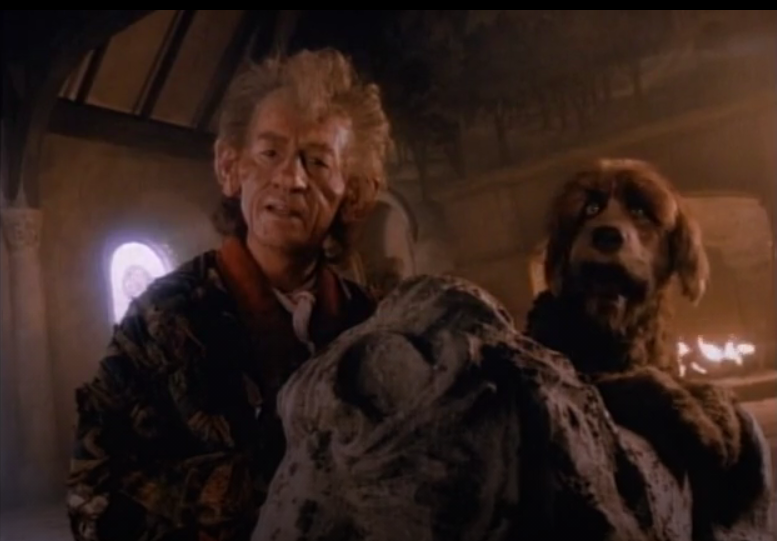
Bibliography
The Project Gutenberg eBook of Household Tales by Brothers Grimm, by Jacob Grimm and Wilhelm Grimm
A Collection of Ballads, by Andrew Lang (gutenberg.org)
The Project Gutenberg eBook of Household Tales by Brothers Grimm, by Jacob Grimm and Wilhelm Grimm
Stone Soup: Folktales of Type 1548 (pitt.edu)
The Project Gutenberg eBook of Celtic Folk and Fairy Tales, by Joseph Jacobs
The Project Gutenberg eBook of Household Tales by Brothers Grimm, by Jacob Grimm and Wilhelm Grimm
The Project Gutenberg eBook of Household Tales by Brothers Grimm, by Jacob Grimm and Wilhelm Grimm
The Project Gutenberg eBook of The Soldier and Death, by Arthur Ransome
The Project Gutenberg eBook of Household Tales by Brothers Grimm, by Jacob Grimm and Wilhelm Grimm
The Project Gutenberg eBook of Household Tales by Brothers Grimm, by Jacob Grimm and Wilhelm Grimm
The Project Gutenberg eBook of Household Tales by Brothers Grimm, by Jacob Grimm and Wilhelm Grimm
The Project Gutenberg eBook of The Fairy Tales of Charles Perrault, by Charles Perrault, et al
The Project Gutenberg eBook of Household Tales by Brothers Grimm, by Jacob Grimm and Wilhelm Grimm
The Project Gutenberg eBook of The Fairy Tales of Charles Perrault, by Charles Perrault, et al
References
| ↑1 | It had a spinoff about Greek myths which only lasted four episodes. While it’s just as great as the main show, tracing down different versions of classical myths is a more daunting task for me than looking at different European fairy tales, so I won’t be covering it. |
|---|---|
| ↑2 | The episode, The Luck Child credits a “Russian folktale” and the costumes certainly set it in that country, but I’ve been unable to hunt down what that folktale might be, so I’m going to just write about the German folktales which strikes me as its inspiration. It’s likely they were part of it anyway, even if the mysterious Russian variant was the main source. The Heartless Giant is credited to a “German folktale” but it seems pretty obviously based on the Norwegian one, The Giant Who Had No Heart in his Body. If any fairy tale experts out there would like to clarify these issues, I’d be happy to edit this post based on their input. |
| ↑3 | Howard Pyle does much the same thing in his books, The Wonder Clock and Twilight Land. |
| ↑4 | This plot dates back to the myth of Cupid and Psyche. |
| ↑5 | Since I’m not super familiar with the different variants of this story, I can’t say which of the incidents come from Minghella’s imagination and which from them. I’d love it if anyone has any information to share. |
| ↑6 | Aficionados of the Brothers Grimm will be reminded of Godfather Death, Gambling Hansel and Brother Lustig. |
| ↑7 | Lovers forgetting their betrotheds, either through enchantment or because they’re just stupid, is a surprisingly common plot in Grimm. The version in The True Bride is probably the worst, with the heroine neither avoiding her beloved after his betrayal or trying to speak to him and being prevented by the false bride. Instead, she visits him three times, only revealing her identity on the last occasion. |
| ↑8 | Actually, there are many fairy tales with that story’s climax, like The Iron Stove or The Singing, Springing Lark. Perhaps I should cite one of them as the inspiration for this episode since the true bride keeps the objects she uses for bargaining in walnuts in them. But the false bride being a troll princess and prisoners in a dungeon being the ones to alert the beloved to his bride’s presence come from East of the Sun and West of the Moon. |
| ↑9 | There’s not really a good translation. It’s something like Lots-of-Different-Furs. |
| ↑10 | This episode is closer to the Grimm versions of Allerleirauh and Cinderella than those by Charles Perrault. The princess’s disguise is made from the fur of many different animals and her slipper is made of gold. But I’ll be including links to all four stories in the bibliography, since the Perrault version of Cinderella is the most iconic and I don’t want people to get confused. Plus it’s interesting to compare how Perrault and Grimm handled the same material. |
| ↑11 | This arguably owes something to Iron Johannes. Maybe that’s the reasoning behind the “early German folktale” credit. |
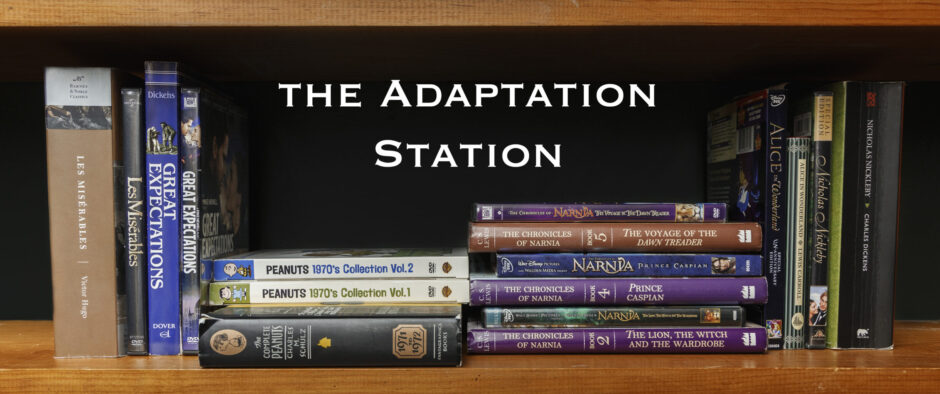
I LOVE adaptations of folklore! I happen to think you are fairly good at that yourself 😉 I had to stop reading this post because I’ve decided I need to go watch the show first. Any idea where I can find it?
Well, at the moment, it looks like it’s included with an Amazon Prime subscription. So is the Greek Myths spinoff.
https://www.amazon.com/Fearnot/dp/B07PWN3PNY/ref=sr_1_1?crid=271ETCDRZGP2S&keywords=The+Storyteller&qid=1649513973&s=instant-video&sprefix=the%2520storyteller%2Cinstant-video%2C105&sr=1-1
https://www.amazon.com/Perseus-the-Gorgon/dp/B07NSFXKXR/ref=sr_1_2?crid=271ETCDRZGP2S&keywords=The+Storyteller&qid=1649514549&s=instant-video&sprefix=the%2520storyteller%2Cinstant-video%2C105&sr=1-2
If you don’t have Amazon Prime, they can be watched for free on Archive.org. That’s where I got the images for this blogpost. But I’m not sure how ethical that is.
https://archive.org/details/jim-hensons-the-storyteller-mkv
https://archive.org/details/jim-hensons-the-storyteller-greek-myths-mkv